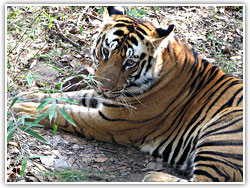|
|
Wildlife in North India
.............................................................................................................................................................................. |
|
|
|
There are vast variations in
geography, climate and vegetation in India. As a
result, there is exciting diversity in habitats,
animals and birds. The Himalayas, the highest
mountains in the world, offers a wide range of
landscapes and wildlife. The northern plains, the
course of the holy rivers Ganga and the Yamuna,
the Great Thar Desert in the west, the Sundarbans
Delta of the Ganga and the Brahmaputra in the
east, the ancient volcanic rock of the Deccan
Plateau and the Western Ghats with their dense,
luxuriant forest |
 |
|
|
provides fascinating variations
in habitats. In India, the total area covered by
wildlife is approximately 90,000 sq km and
constitutes 3 per cent of the country’s land area.
India has a long tradition of protecting and preserving
wildlife. The need for conservation of the environment
and the forests was felt by the Indian rulers from the
ancient times. In the 3rd century BC, the Emperor Ashoka
issued edicts to protect forests and natural wealth.
Later during the reign of the Emperor Chandragupta
Maurya, “forests free from fear” were identified and
protected. In more recent times, the administrators and
princely rulers demarcated and reserved forests as
private preserves. Today many of these form the nucleus
of India’s wildlife sanctuaries and parks. Indian
literature also has references for concern for earth as
well as for forests and its inhabitants. Earlier,
British rulers and the Indian Maharajas hunted various
wildlife animals, but later the Government of India took
certain steps to protect these animals. Since 1970,
wildlife has been protected by the Central and the State
Government through legislation. Various Indian leaders
like Jawaharlal Nehru and Indira Gandhi also took a keen
interest in the protection of wildlife. Due to their
efforts only, the species which were on the verge of
extinction have survived. The emphasis has been not only
on protecting wildlife in reserved forests, but also on
creating the harmony between man and animal. The demands
of a rapidly increasing population continue to put
pressure on surviving forests in India. Vast herds of
black buck, that roamed the northern and western plains
50 years ago, are now found only in sanctuaries and
around the villages of the Bishnoi tribes, who protected
them. The project Tiger was started in 1973. but, today
it is a massive attempt towards the conservation of the
tiger and its environment. It covers 23 National Parks
and Sanctuaries and its success can be judged from the
fact that the number of tigers in India has gone up
significantly since the project was launched.
There are about 80 National
Parks and 441 Sanctuaries in India. Several
national parks and sanctuaries of India are
conveniently accessible by car and also have good
accommodation. More than 350 mammals and 1,200
species of birds and reptiles are found in India,
some of which are unique to this subcontinent.
Some of these unique wild animals and birds are
the white tiger, the royal Bengal tiger, the snow
leopard, the Asiatic lion, the lion-tailed
macaque, the Himalayan Tahr, one horned
rhinoceros, the Andaman teal, the great Indian
bustard and the Monal pheasant. Sighting of
animals in India has a thrill of its own. Various
animals like deer and elephants can be seen in
small herds in dense forests and in isolated
places, except the tiger. You can view the animals
by either having an elephant safari, jeep safari
or canter safari. Elephant safari is the best way
to view these animals as everything which moves
can be noticed from the height and if you are
lucky, you might see a rare animal. |
|
|
|
National Parks & Wildlife Sanctuaries in North
India (Statewise) |
|
Following are some of the famous wildlife
sanctuaries and national parks of North India:
|
|
Name of
National Park / Sanctuary |
Best
time to Visit |
Animals
& Species found |
|
Madhya
Pradesh |
|
Kanha National Park |
March - June |
Tiger, panther, gaur,
barasingha, chital, samber, blackbuck, four-horned
antelope, barking deer, mouse deer, nilgai, wild
dog, boar |
|
Bandhavgarh National Park |
November - June |
Tiger, panther, gaur, chital,
sambar, nilgai, chinkara, barking deer, bear, wild
boar and a variety of upland birds. |
|
Punjab |
|
Harike Headworks Sanctuary |
October - March
|
Duck, pochard, teal, coot,
waterhen, geese, nilgai and wild boar |
|
Uttar
Pradesh |
Corbett National Park
(Tiger Reserve) |
November - May
|
Elephant, tiger, panther, sloth
bear, nilgai, sambar, chital, wild boar,
porcupine, peafowl, red jungle fowl, partridge,
both species of Indian inland crocodiles, goral
and four-horned antelope. |
|
Dudhwa National Park |
November – May |
Tiger, panther, sloth bear,
sambar, swamp deer, barking deer, nilgai, peafowl,
junglefowl, partidge, etc. |
|
|